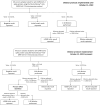Prozone masks elevated SARS-CoV-2 antibody level measurements
- PMID: 38547209
- PMCID: PMC10977713
- DOI: 10.1371/journal.pone.0301232
Prozone masks elevated SARS-CoV-2 antibody level measurements
Abstract
We report a prozone effect in measurement of SARS-CoV-2 spike protein antibody levels from an antibody surveillance program. Briefly, the prozone effect occurs in immunoassays when excessively high antibody concentration disrupts the immune complex formation, resulting in a spuriously low reported result. Following participant inquiries, we observed anomalously low measurement of SARS-CoV-2 spike protein antibody levels using the Roche Elecsys® Anti-SARS-CoV-2 S immunoassay from participants in the Texas Coronavirus Antibody Research survey (Texas CARES), an ongoing prospective, longitudinal antibody surveillance program. In July, 2022, samples were collected from ten participants with anomalously low results for serial dilution studies, and a prozone effect was confirmed. From October, 2022 to March, 2023, serial dilution of samples detected 74 additional cases of prozone out of 1,720 participants' samples. Prozone effect may affect clinical management of at-risk populations repeatedly exposed to SARS-CoV-2 spike protein through multiple immunizations or serial infections, making awareness and mitigation of this issue paramount.
Copyright: © 2024 Sandoval et al. This is an open access article distributed under the terms of the Creative Commons Attribution License, which permits unrestricted use, distribution, and reproduction in any medium, provided the original author and source are credited.
Conflict of interest statement
The authors have declared no competing interest.
Figures
References
-
- Lim SY, Park S, Kim JY, Kim S, Jee Y, Kim SH. Comparison of Waning Neutralizing Antibody Responses Against the Omicron Variant 6 Months After Natural Severe Acute Respiratory Syndrome Coronavirus 2 Infection (With or Without Subsequent Coronavirus Disease 2019 [COVID-19] Vaccination) Versus 2-Dose COVID-19 Vaccination. Clin Infect Dis. 2022. Dec 19;75(12):2243–2246. doi: 10.1093/cid/ciac435 - DOI - PMC - PubMed
-
- Rydyznski Moderbacher C, Ramirez SI, Dan JM, Grifoni A, Hastie KM, Weiskopf D, et al.. Antigen-Specific Adaptive Immunity to SARS-CoV-2 in Acute COVID-19 and Associations with Age and Disease Severity. Cell. 2020. Nov 12;183(4):996–1012.e19. doi: 10.1016/j.cell.2020.09.038 Epub 2020 Sep 16. - DOI - PMC - PubMed
MeSH terms
Substances
LinkOut - more resources
Full Text Sources
Medical
Miscellaneous


